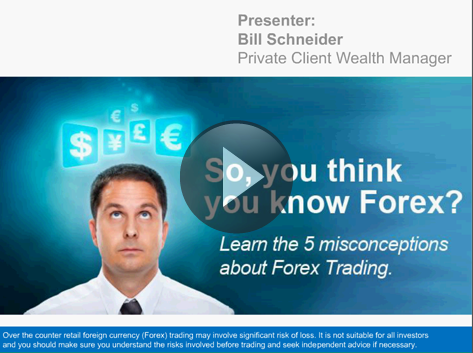Forex trading misconceptions
Post on: 30 Март, 2015 No Comment

The difference between an experienced trader and a novice is that the experienced trader knows what he needs to know. While each trader learns at his own pace, the experience of wins and losses is the best teacher. However, this process is inefficient and bad habits are likely to be picked up along the way. As a result, many traders approach the forex market with misconceptions that limit profits. Here are some leading forex misconceptions.
1. Stops are technical in nature: While stops are necessary, the challenge is in creating rules to avoid placing stops too close to the natural vibration of prices, or too far away, which can result in catastrophic losses. Placing stops at previous support or resistance is too vague. A better approach pays attention to risk control. Once a trader settles on a defined dollar risk per day, stop placement can be determined. If a trader is buying a currency pair off a 15-minute time-interval, and the recent support is 50 pips, the trade itself should not be taken if the risk per day will be exceeded. Stops are technical in nature, but never independent of cash management.
2. Leverage and risk are synonymous: Some forex brokerage firms offer up to 400:1 leverage. The ability to put on forex trades with a small amount of money is attracting people to forex with the hopes of quick profits. When the trade works, the high leverage results in astounding returns. A $5,000 account could earn $500, 10%, on a 10-pip move. Yet, when the trade doesnt work, the consequences can be catastrophic. Many new traders simply put on large multiple lot trades indiscriminately. That is when high leverage is dangerous. A Porsche can easily achieve 150 miles per hour, but you wouldnt drive that fast in downtown traffic. Utilize high leverage only when you have identified a limited-risk trade and be sure to make adjustments for slippage.
3. Technicals alone generate trade signals: Simply looking at a chart provides insufficient data to make a trading decision in forex. Without knowing the fundamentals, the trader may make erroneous conclusions. A common mistake is to believe prices have to retrace after a large move. While profit taking occurs, currency prices move in response to new fundamental information and do not have to retrace at all. Traders who expect retracements sometimes watch the trade move hundreds of pips against them. Good charting analysis is vital but a trader needs to consider the fundamental forces that move the charts.
4. Overnight trading is riskier than day trading: Often new traders are trained to concentrate on intraday trading and to avoid holding positions overnight. There is an assumption that risk increases the longer a position is held, but longer duration trades provide time for a position to work, particularly in a volatile market. Trading with the trend is less risky. A long-term trade in the direction of the trend may take more time to work, but has a higher probability of profitability than a short-term trade that looks to scalp a few pips. Overnight trades require much lower leverage. By using appropriate levels of risk control, forex traders can profit from longer-term trades.
5. Forex trading systems work: The popularity of forex trading has resulted in a deluge of forex systems and signals sold at the retail level promising unprecedented performance. These products often are useful for the retailer of the trading system but not the user. They appeal to the desire of traders to take a short cut to profitability. At best these retail products provide added confirmation; it is best to develop your own expertise.
6. Emotions are dangerous: The use of emotions in trading is often the focus of a great deal of criticism. Emotions are not separable from a person, they contribute to trading intelligence. Recognizing a winning pattern generates a high level of confidence that acts as an emotional trigger to the trade. Emotions are not dangerous, the challenge is to use them correctly and not ignore them.
7. Backtesting works: Many traders look to develop their own systems or approaches to trading by backtesting their rules. Backtesting can verify the effectiveness of your rules for trading, but the misconception when applied to forex is that the trading environment of the backtesting is applicable to the future. Forex market conditions are not linear; they are dynamic and are affected by the complex and changing world economy. Todays global economy and geopolitical environment is significantly different than that of even two year ago. A global cycle of interest rate increases was beginning; the war in Iraq had begun; Japan was in a deflationary cycle and Alan Greenspan was head of the Fed. A back test during this time would not be able to capture the nuances of a changing world.

8. News feeds provide an edge: A misconception nurtured by the growing forex industry is that forex traders can get an edge through news feeds purportedly ahead of the public release. Even if advanced releases are available, which is a dubious claim, they probably arent useful. Markets react based on the divergence of reports to the markets expectations and it is doubtful large interbank dealing rooms share those expectations or are behind the news curve.
Abe Cofnas is president of learn4x.com LLC and author of Understanding Forex: Trading to Win. E-mail: learn4x@earthlink.net.














